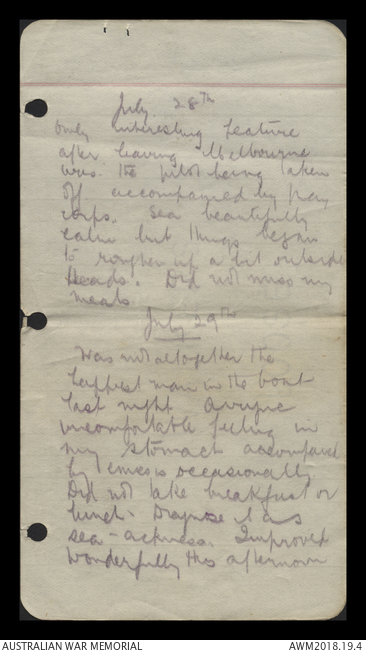| Ranks Held | Captain, Major |
|---|---|
| Birth Date | 18/12/1891 |
| Birth Place | Australia: Victoria, Nathalia |
| Death Date | 03/01/1949 |
| Final Rank | Major |
| Service | Australian Imperial Force |
| Units |
|
| Place | Nathalia |
| Conflict/Operation | First World War, 1914-1918 |
Major Keith McKeddie Doig


Keith McKeddie Doig was born at Nathalia in northern Victoria on 18 December 1891, the eldest son of Mitchell, the head teacher at the local state school, and Henrietta Eliza (nee McKeddie). His mother moved to Geelong with her two children in 1901, where she and her late husband originally heralded. After a short stint at Flinders State School, Doig gained a junior scholarship to Geelong College in 1905, where he excelled in both academic and sporting spheres. He was named dux of the college in 1908, received the Dr. Kearney Memorial Prize for excellence in the combined pursuits of academics and sports in 1909, and subsequently secured a scholarship to Ormond College at the University of Melbourne.
Doig pursued medicine at Ormond College, his place supported in part through the assistance of Norman Morrison, his former headmaster at Geelong College. His benefactor’s sudden death in late 1909 prompted Doig to pursue holiday work picking grapes in Mildura to finance his studies. Nevertheless, he continued his parallel success in academic and sporting pursuits at university, where he won blues in football and cricket. He played 44 games with University in the Victorian Football League, and in cricket was compared to the likes of Vernon Ransford, an attractive left-handed batsman who was regarded as one of the best outfielders for the Australian cricket team at the time.
Doig graduated from the University of Melbourne with a Bachelor of Medicine and Bachelor of Surgery in April 1915, and shortly after commenced as a junior resident at Melbourne Hospital. After a year in the role he aborted ambitions to join the Alfred Hospital and instead enlisted with the Australian Imperial Force on 1 May 1916. He was assigned to the Australian Army Medical Corps with the rank of captain, and embarked from Melbourne on board HMAT Themistocles on 28 July 1916. Doig disembarked at Devonport on 11 September and briefly served as a medical officer at Pelham Downs and Southall before proceeding to France on 18 October 1916.
Upon arriving in France, Doig was initially posted to the 8th Field Ambulance. He was transferred to the 60th Infantry Battalion as regimental medical officer on 24 November 1916, and remained with the battalion until June 1918. During this period ‘his influence was profound and his courage and character were to mark many men for the rest of their lives.’ In line with this description, he was awarded the Military Cross (gazetted 1 January 1918) for exceptional service on the Somme and at Bullecourt from February to September 1917. The concluding note to his citation declared that Doig ‘proved himself to be one who does work of the highest quality under the most arduous circumstances. His courage and devotion to duty deserves special recognition.’
On 20 June 1918 Doig was transferred to the No.1 Australian General Hospital at Rouen, where he was promoted to temporary major on 30 October, his commission to major officially confirmed shortly after. Following the Armistice, the hospital at Rouen was closed with Doig detached to an Advance Party as part of the demobilisation of Australian troops. He proceeded to Sutton Veny in England on 17 December, where he assumed the role of registrar at the recently re-established No. 1 Australian General Hospital from 25 January to 22 April 1919.
In response to programs facilitating the repatriation and demobilisation of Australian troops, Doig was granted leave for non-military employment under the Inter Allied Fellowship of Medicine. He subsequently attended a post graduate medical course in London from 28 April to 20 June 1919. The course was cancelled over a month early, which hastened his departure from England. Doig embarked from Plymouth on board SS Canberra on 23 July, and disembarked at Melbourne on 11 September 1919.
In March 1920 Doig married his long-time fiancée Lewis ‘Louie’ Maffra Grant at College Church, Parkville, the service conducted by former Captain Chaplain Frank Milne. Around this time Doig started a medical practice with William Henry Brown and his son Arthur, a fellow medical officer he met whilst serving in France. This partnership maintained a small private hospital until 1934, when they relocated their private practice to the confines of the newly opened Colac Community Hospital. Doig practiced at this location for the remainder of his working life, where his interests largely lay in the direction of medicine and midwifery. He was admitted to the Royal Australasian College of Physicians in 1940.
Many of Doig’s post-war associations stemmed from strong links and friendships forged during his formative years at college and whilst serving overseas. He was a long-standing member of the Old Geelong Collegians Association, and during his tenure as president, fittingly unveiled a memorial bust in honour of his former headmaster, Norman Morrison. Doig also retained strong ties to Ormond College and his former regiment via the 60th Battalion Association. His sporting interests after the war turned to tennis, a sport he not only excelled at, but also administered as president of the Colac Tennis Club.
Doig died at his holiday home at Lorne on 3 January 1949. His funeral took place at Colac three days later, where over 200 people gathered to pay their respects near his residence in what the local newspaper described as ‘a striking mark of respect for an outstanding citizen.’ On the first anniversary of his death, a bronze bust of Doig was unveiled at the Colac Hospital in honour of the late doctor.



